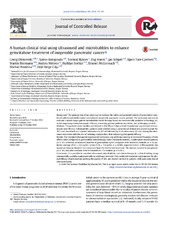| dc.contributor.author | Dimcevski, Georg Gjorgji | en_US |
| dc.contributor.author | Kotopoulis, Spiros | en_US |
| dc.contributor.author | Bjånes, Tormod Karlsen | en_US |
| dc.contributor.author | Hoem, Dag | en_US |
| dc.contributor.author | Schjøtt, Jan | en_US |
| dc.contributor.author | Gjertsen, Bjørn Tore | en_US |
| dc.contributor.author | Biermann, Martin | en_US |
| dc.contributor.author | Molven, Anders | en_US |
| dc.contributor.author | Sorbye, Halfdan | en_US |
| dc.contributor.author | McCormack, Emmet | en_US |
| dc.contributor.author | Postema, Michiel | en_US |
| dc.contributor.author | Gilja, Odd Helge | en_US |
| dc.date.accessioned | 2017-09-19T12:25:32Z | |
| dc.date.available | 2017-09-19T12:25:32Z | |
| dc.date.issued | 2016-12 | |
| dc.Published | Dimcevski G, Kotopoulis S, Bjånes TK, Hoem D, Schjøtt JS, Gjertsen BT, Biermann M, Molven A, Sorbye H, McCormack E, Postema M, Gilja OH. A human clinical trial using ultrasound and microbubbles to enhance gemcitabine treatment of inoperable pancreatic cancer. Journal of Controlled Release. 2016;243:172-181 | eng |
| dc.identifier.issn | 1873-4995 | |
| dc.identifier.issn | 0168-3659 | |
| dc.identifier.uri | https://hdl.handle.net/1956/16668 | |
| dc.description.abstract | Background: The primary aim of our study was to evaluate the safety and potential toxicity of gemcitabine combined with microbubbles under sonication in inoperable pancreatic cancer patients. The secondary aim was to evaluate a novel image-guided microbubble-based therapy, based on commercially available technology, towards improving chemotherapeutic efficacy, preserving patient performance status, and prolonging survival. Methods: Ten patients were enrolled and treated in this Phase I clinical trial. Gemcitabine was infused intravenously over 30 min. Subsequently, patients were treated using a commercial clinical ultrasound scanner for 31.5 min. SonoVue® was injected intravenously (0.5 ml followed by 5 ml saline every 3.5 min) during the ultrasound treatment with the aim of inducing sonoporation, thus enhancing therapeutic efficacy. Results: The combined therapeutic regimen did not induce any additional toxicity or increased frequency of side effects when compared to gemcitabine chemotherapy alone (historical controls). Combination treated patients (n = 10) tolerated an increased number of gemcitabine cycles compared with historical controls (n = 63 patients; average of 8.3 ± 6.0 cycles, versus 13.8 ± 5.6 cycles, p = 0.008, unpaired t-test). In five patients, the maximum tumour diameter was decreased from the first to last treatment. The median survival in our patients (n = 10) was also increased from 8.9 months to 17.6 months (p = 0.011). Conclusions: It is possible to combine ultrasound, microbubbles, and chemotherapy in a clinical setting using commercially available equipment with no additional toxicities. This combined treatment may improve the clinical efficacy of gemcitabine, prolong the quality of life, and extend survival in patients with pancreatic ductal adenocarcinoma. | en_US |
| dc.language.iso | eng | eng |
| dc.publisher | Elsevier | eng |
| dc.rights | Attribution CC BY-NC-ND | eng |
| dc.rights.uri | http://creativecommons.org/licenses/by-nc-nd/4.0/ | eng |
| dc.subject | Ultrasound | eng |
| dc.subject | Microbubbles | eng |
| dc.subject | Sonoporation | eng |
| dc.subject | Pancreatic cancer | eng |
| dc.subject | Image-guided therapy | eng |
| dc.subject | Clinical trial | eng |
| dc.title | A human clinical trial using ultrasound and microbubbles to enhance gemcitabine treatment of inoperable pancreatic cancer | en_US |
| dc.type | Peer reviewed | |
| dc.type | Journal article | |
| dc.date.updated | 2017-08-22T12:47:20Z | |
| dc.description.version | publishedVersion | en_US |
| dc.rights.holder | Copyright 2016 The Author(s) | |
| dc.identifier.doi | https://doi.org/10.1016/j.jconrel.2016.10.007 | |
| dc.identifier.cristin | 1395256 | |
| dc.source.journal | Journal of Controlled Release | |

